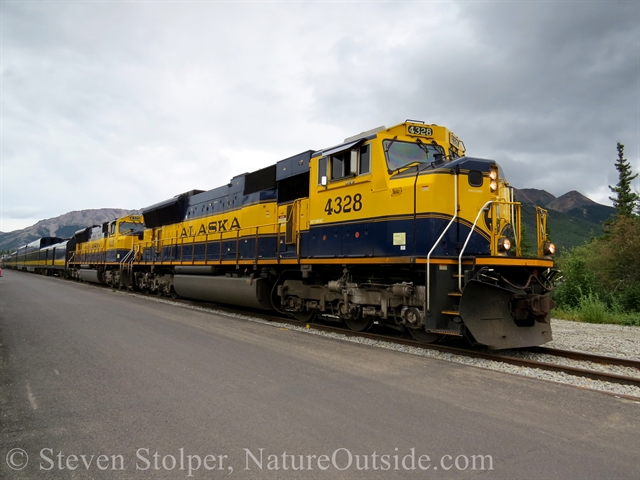
Climb the mountains and get their good tidings. Nature’s peace will flow into you as sunshine flows into trees. The winds will blow their own freshness into you, and the storms their energy, while cares will drop away from you like the leaves of Autumn.
– John Muir, Our National Parks, 1901
I need to get away.
This feeling comes over me from time to time. And when it does, I heed its call. No phones, no Internet, no news of any kind. I seek nature. And slow my pace to match the swaying grass in the breeze.
My Trip to Denali
My plan is to visit Denali National Park in Alaska. The park is named for the awesome mountain that dominates its landscape. Denali towers over the park at 20,310’, and it’s North America’s tallest peak. The name, “Denali,” is Athabascan for “the high one.” And it’s aptly named.
My hope is to observe grizzly bear, moose, and caribou. And if I’m lucky, I’ll spot Dall sheep, beaver, ptarmigan, and lynx.
I plan to stay at a lodge 90 miles inside the park. I’ll use it as a lunching pad to explore different park ecosystems. I hope to bounce on the springy tundra, and stride through the dwarf trees of the Boreal forest.
Since I’ll be in wilderness, there’s no need for a car. It would just sit parked outside the park. You see, Denali National Park is managed like a wilderness – no motorized vehicles. The exceptions are the park buses that shuttle hikers and campers in and out of the park each day.
The obvious choice is to travel to the park by train. The train is an adventurous way to see Alaska’s beautiful scenery. And it’s also reasonably priced. If my goal is to bathe in Alaska’s beauty, there’s no better way than to travel by rail.
From my home in California, I fly to Fairbanks. It will take the train roughly four hours to cover the 122 miles to the park.
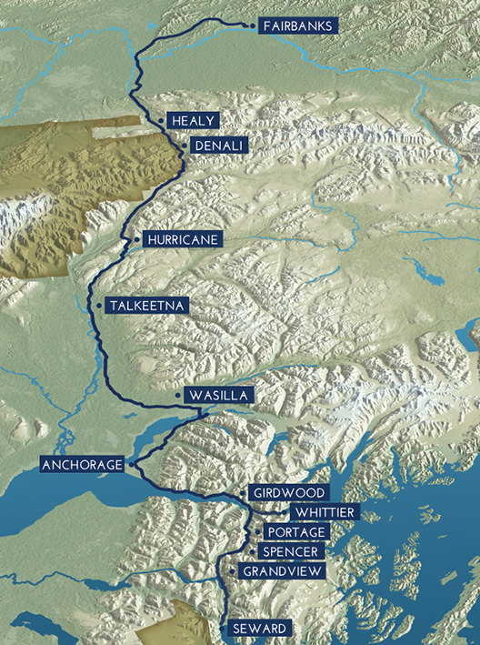
The trip from Fairbanks to Denali takes roughly four hours to cover the 122 miles. (Route Map from Alaska Railroad)
Departure Morning
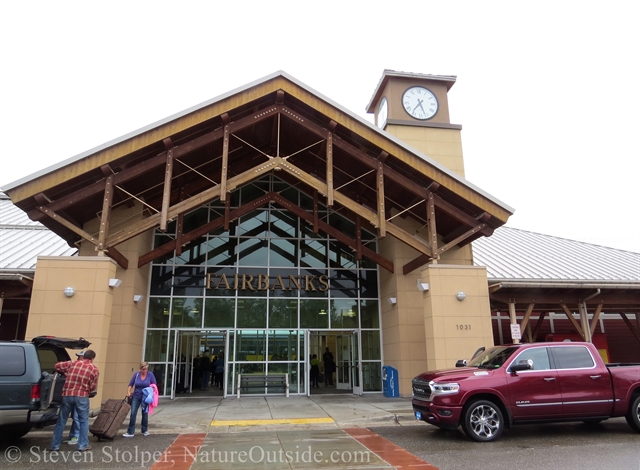
Fairbanks train depot
I arrive at Fairbanks Station at 7:00 am, an hour before the train is scheduled to depart. The low overcast dispenses an intermittent drizzle. I feel that if I stand up straight, my head may disappear in the clouds.
I haven’t seen the sun since I landed in Alaska the day before. And since my home in northern California has a Mediterranean climate, this is the first rain I’ve seen since May.
I zip my rain jacket against the chill breeze. It’s 57 degrees Fahrenheit in early August! But my breakfast of eggs and Reindeer sausage warms me from inside.
Ticketing and boarding
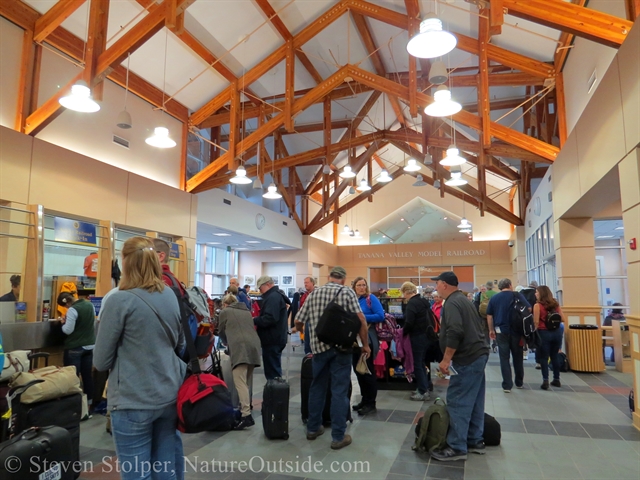
Passengers wait for their boarding passes and to check baggage. Make sure you get a window seat!
I join the line of passengers getting their boarding passes and checking luggage. We’re instructed to do this an hour before departure. Passengers who stay at the main hotels outside the park entrance can have their bags sent directly to their lodging. I’m scheduled to catch a bus into the park about an hour after the train arrives at Denali.
Most travelers have some sort of suitcase or duffel in combination with a daypack. I baggage-check my duffel to Denali. It contains most of my outdoor gear. While my daypack contains my water bottle, snacks, camera, binoculars, lightweight fleece, and rain jacket. I also carry some “essentials,” like contact lenses, in the unlikely event my luggage is lost.
Daniel, our “Train Guide” uses a microphone and loudspeaker to describe what passengers must do to check-in and board the train. Banners on the platform indicate where each group boards their assigned carriage. The letters on the banners correspond to our boarding passes.
We hear the “All Aboard!” and mount the steps to our assigned seats.
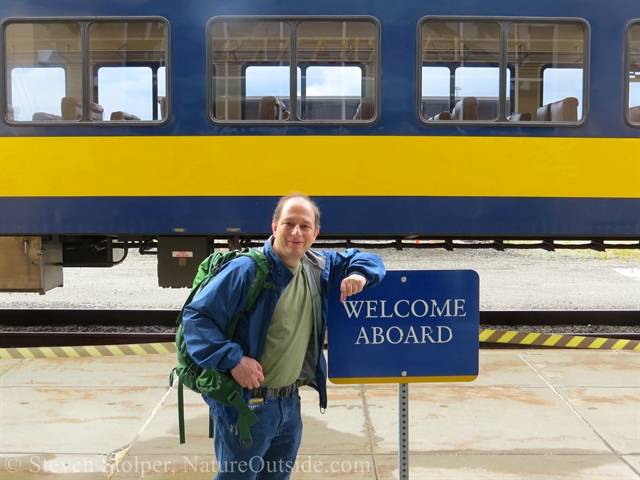
Waiting to board with my daypack. My train ticket is conspicuous in my front pocket. I’m wearing my rain jacket (a theme during my visit).
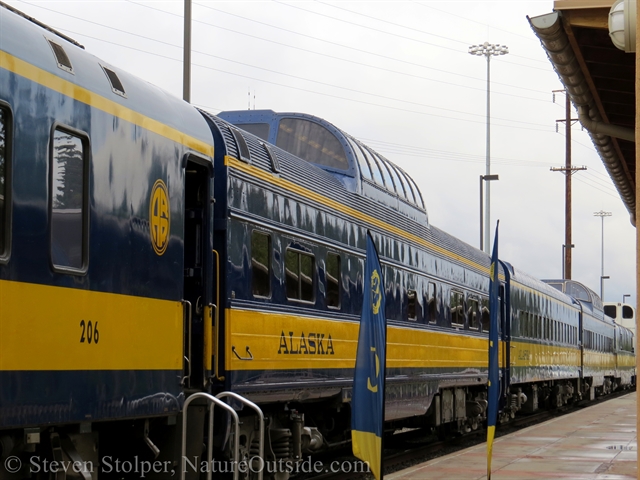
Banners mark the boarding locations. The letters correspond to those on our boarding passes.
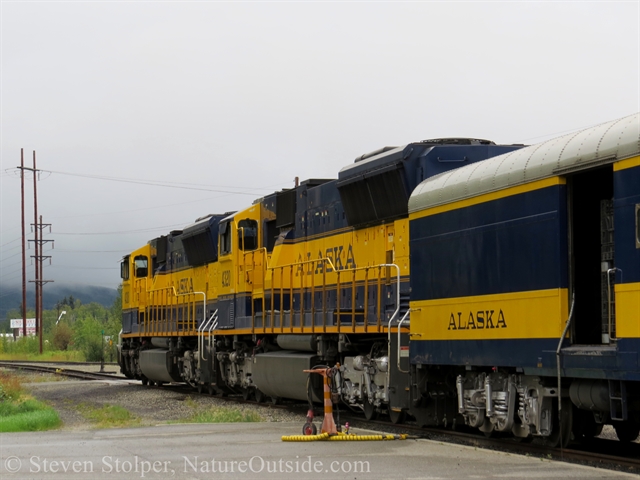
The diesel engines are ready to go! The baggage car is just behind.
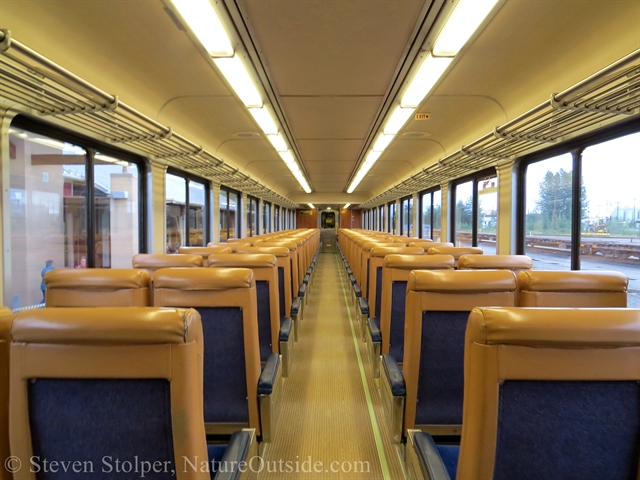
I’m first aboard. This is the empty passenger car.
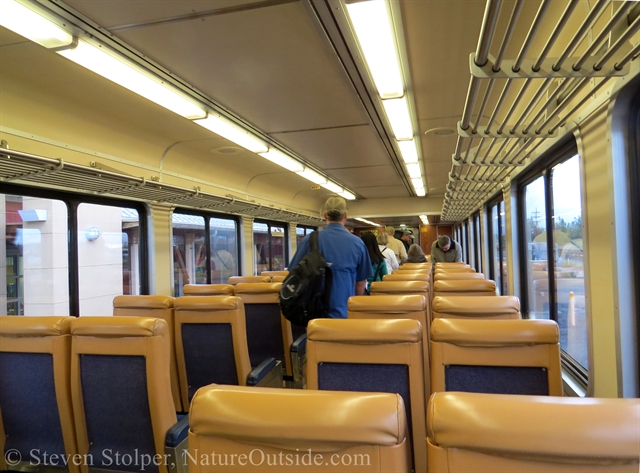
Passengers take their seats. It is not crowded.
On the Train
Fairbanks began as a mining town in 1901. It’s the northern terminus of the Alaska Railroad and the gateway to the Haul Road that leads to the North Slope oil fields. It’s population of about 33,000 makes it Alaska’s third largest city. And about 100,000 people live in the region.
We depart the station and pass the University of Alaska Fairbanks. It’s said to be the furthest north of any university in the world. I’m surprised to learn more than 8,000 students attend the school.
The train trundles along at a modest 30 mph, giving us plenty of time to absorb the scenery. Our Train Guide keeps a constant stream of narration as we go. Several times the train slows for wildlife. You’re more likely to see wildlife at the front of train, as the noise usually flushes the animals.
Permafrost
Most of what I see is taiga – the swampy coniferous forest found in high northern latitudes. The White spruce along the tracks reach no higher than 10 to 15 feet tall. White spruce grows primarily in taiga. And it’s easily the northernmost tree species on Earth. It grows as far north as 69 degrees North latitude.
There are two reasons the trees are small. One is the short growing season. The second is permafrost. The ground is frozen solid, year-round, 6-12 feet below the surface. This prevents tree roots from going very deep. It’s estimated that permafrost is found to some extent beneath nearly 85% of Alaska.
Many parts of Alaska see little precipitation, and are actually arid. But the permafrost forms an impenetrable barrier, like concrete, to water beneath the surface. Rainfall and snowmelt do not drain through the ground. Instead, water collects at the surface.
The water nourishes plants and forms shallow lakes that provide food and water for animals. The plants return the favor by insulating the permafrost beneath them so it remains frozen throughout the year. You can estimate the depth of the permafrost below the ground by looking at the size and species of plants that grow at the surface. The contrast between areas with permafrost and patches without it are striking!
Permafrost creates the taiga, tundra, and boreal forest ecosystems we see in the subarctic. But studies show that much of the permafrost in Alaska is warming significantly, and some of it is thawing. If the permafrost thaws, the entire ecosystem will change from what we know today. In addition, thawing permafrost may actually release methane and carbon dioxide gases into the atmosphere, which would further accelerate global warming. If humans do not take steps to prevent global warming, our children will never see the incredible subarctic scenery I’m viewing from the train.
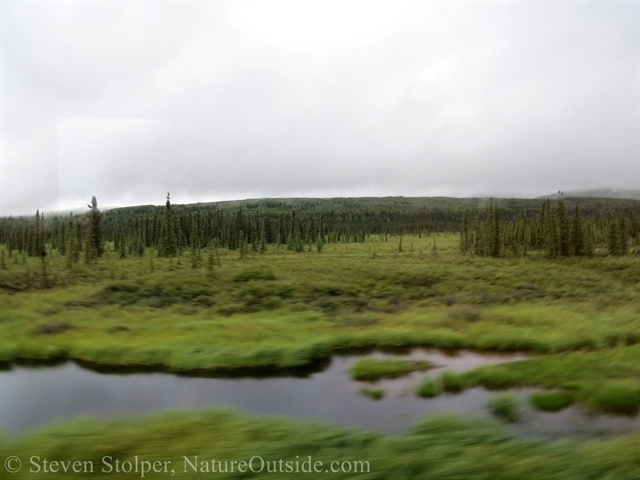
Wet tundra with Boreal forest in the distance. Some of these valleys see winter temperatures of -55 degrees Fahrenheit.
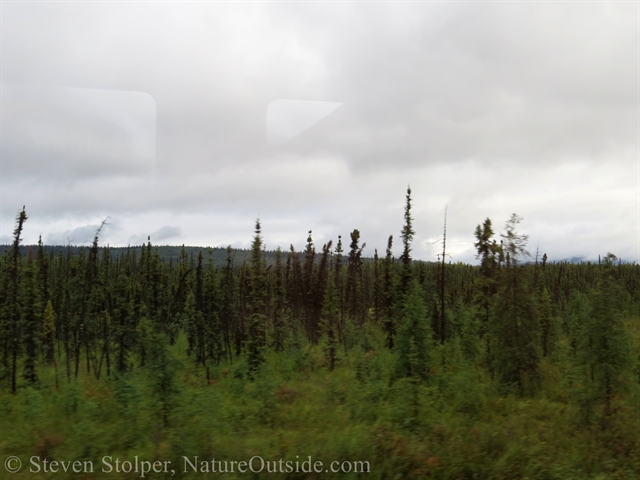
White spruce in the Boreal forest.
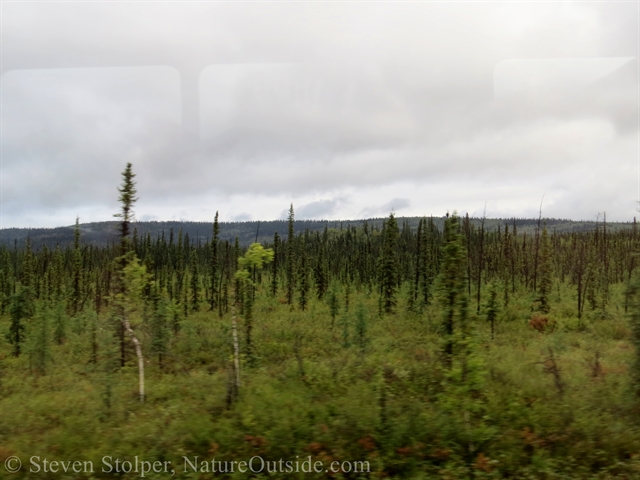
Boreal forest seen from the train.
Between Cars
One of the benefits of traveling by train is that you can wander around. And the crew actively encourages passengers to do so. My favorite spot is between cars. It’s open to the air and I can take in the landscape while the wind rushes by.
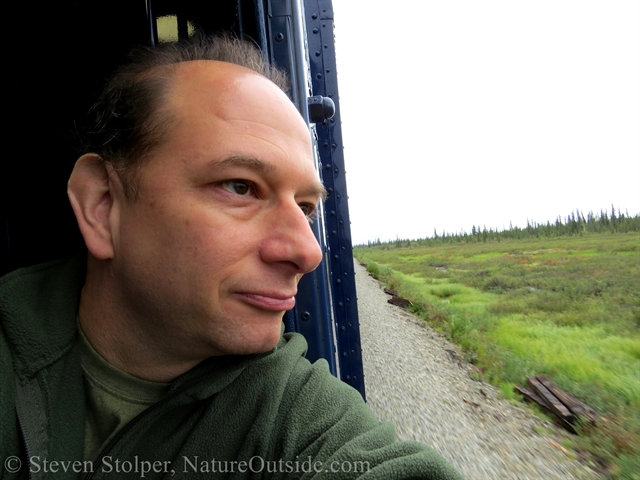
Contemplating Alaska in the open air, on the platforms between cars.
The train slows, and the Train Guide announces that we’re passing an Osprey nest built on one of the old telegraph poles. The warning is quick, and my photography leaves a lot to be desired.
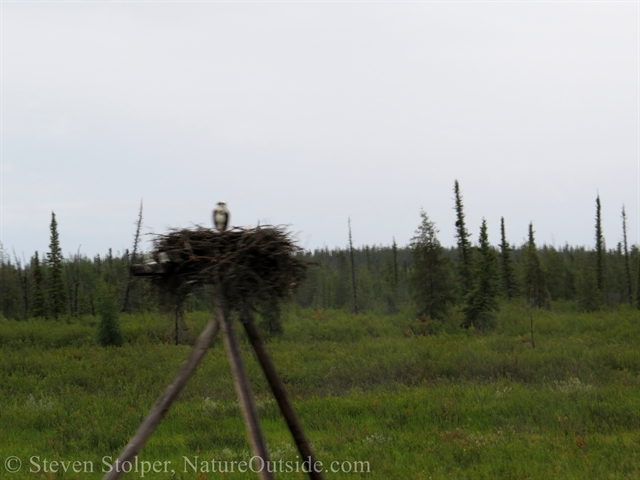
The Osprey nest is huge! The old telegraph poles are wooden tripods about 15 feet above the ground.
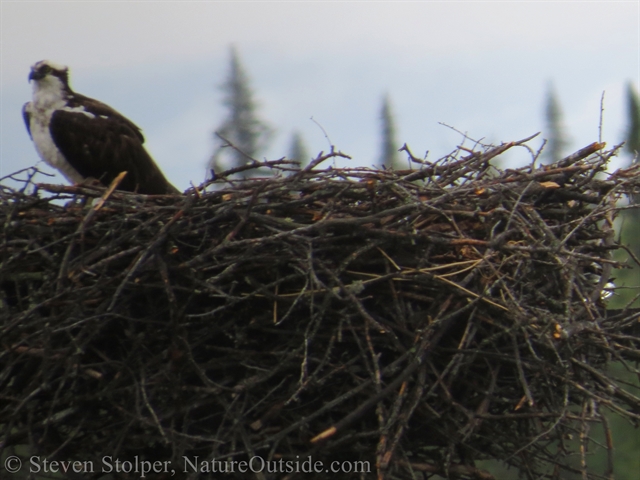
Osprey on the nest. They are whiter than most raptors and have a broad brown stripe through the eye.
The train lumbers on and I head to the observation car.
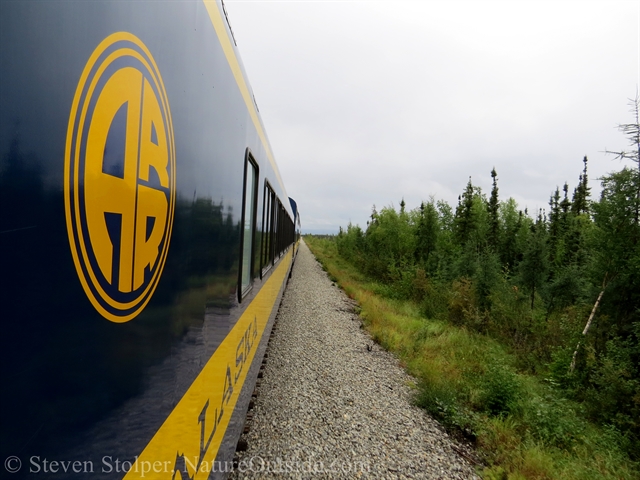
View looking up the train from the platform between cars. Some curves are so tight that the engines are clearly in view from my seat inside the car.
Observation Car
The observation car is a great place to take in the view. The seats are not reserved, so anyone can wander in and sit down. But the crew asks that you don’t monopolize the seats.
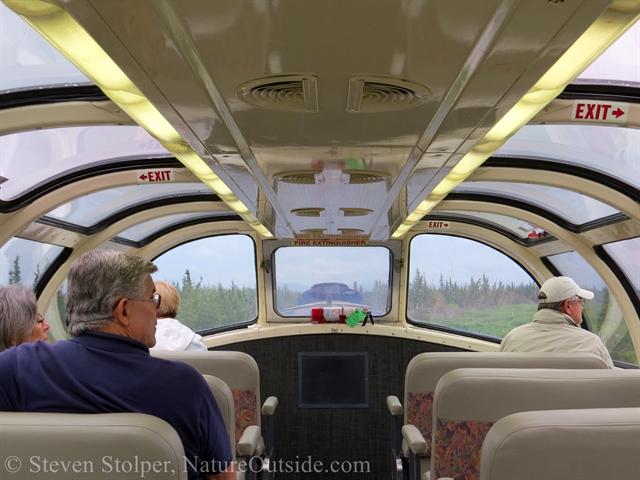
The viewing deck of the observation car
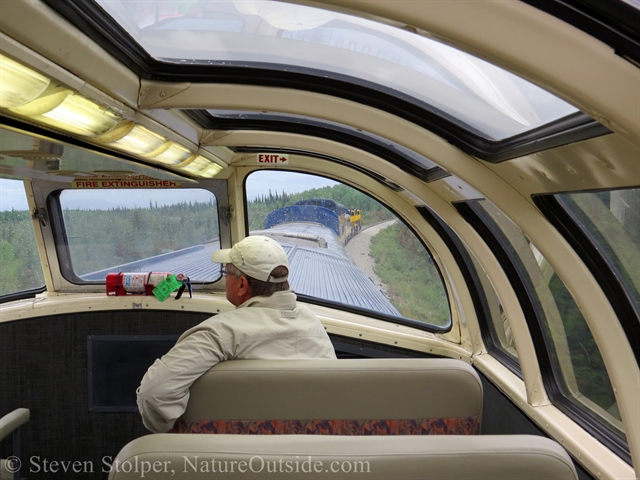
Another view of the observation car
Other parts of the train
There are all sorts of cool tools located throughout the train.
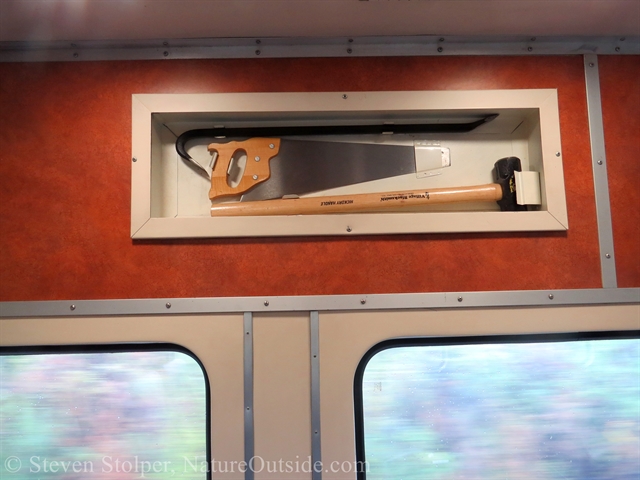
Storage compartments for tools are built into the train cars.
Here’s the dining car. There are two options to dine. You can “sit down dine” by adding your name to a list. As tables become available, you are called to eat. You can also “grab and go” by purchasing snacks and food to eat at your seat. I munched on snacks I brought with me onto the train.
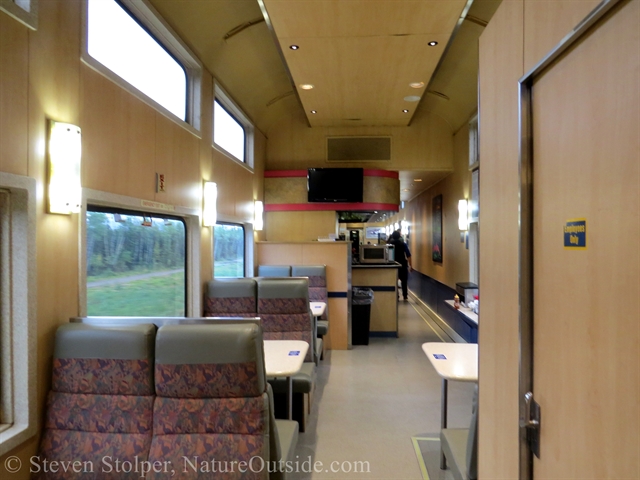
The interior of the dining car
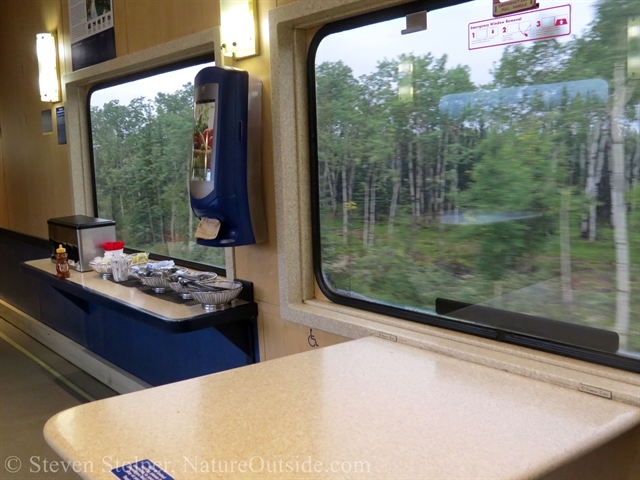
The dining car
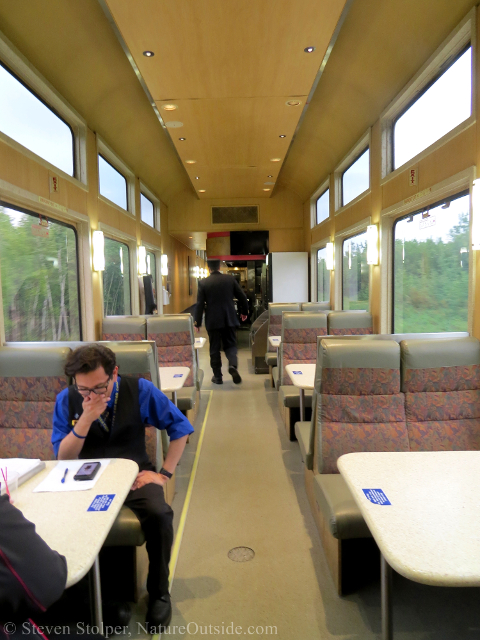
The dining car has an excellent view.
Arrival
Finally, after an enjoyable ride, we arrive at Denali. These photographs are of another train from Fairbanks arriving at the station.
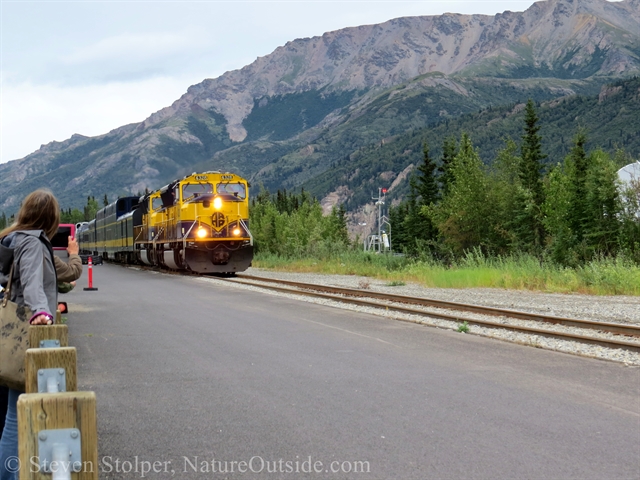
Train from Fairbanks arriving at the Denali depot
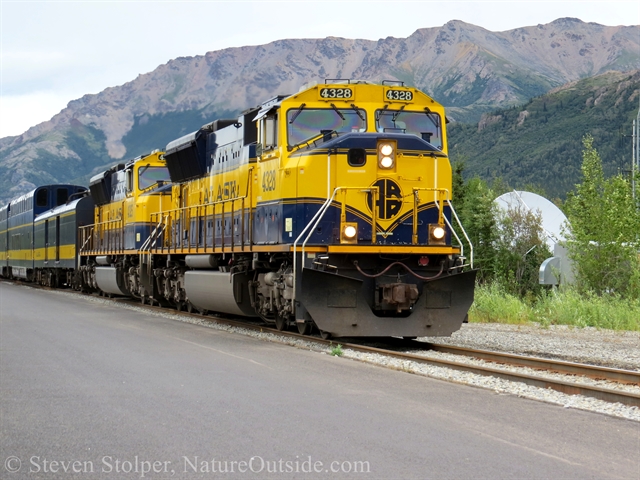
Chugging into Denali depot
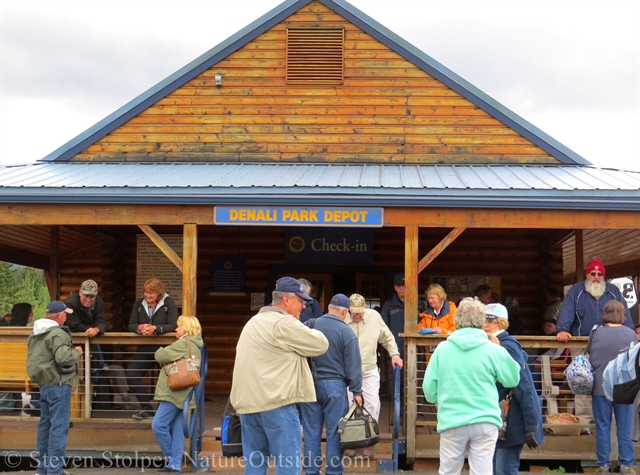
Passengers milling about the main building. Some are getting ready to board for the trip to Anchorage.
I retrieve my duffel and set out for adventure…
More Adventure to come
This is only part of my trip to Denali National Park. As I complete each article, I will add a link below.
Denali — The Tale of Ten Bears
Denali – Kettle Ponds and Caribou
For fun facts and useful tips, join the free Bushcraft Newsletter.



Great writeup Steve. Looking forward to more
Thanks, Awatermanswoods!
We took the train from Anchorage to Denali many years ago. Brings back really fond memories. Looking forward to your next post.
Thanks, Ardis! The trip from Anchorage to Denali is much longer than from Fairbanks. It must have been a wonderful trip.